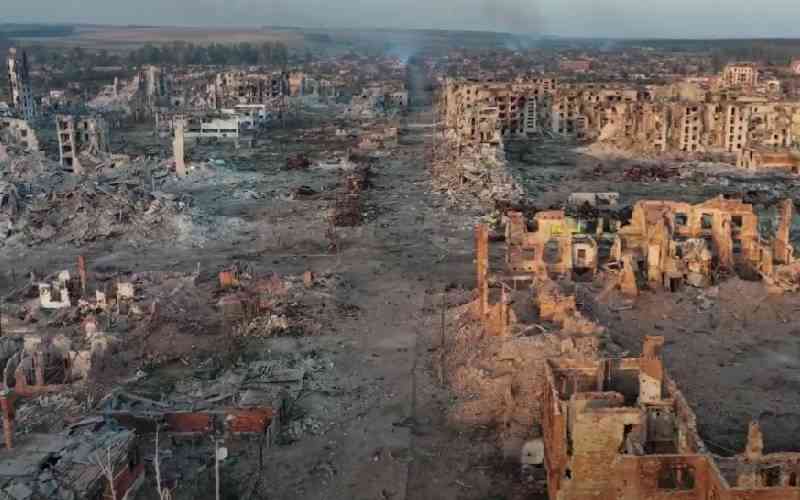Building your own house is never a cheap affair. But there are aspects you could consider to save on cost.
HOME and AWAY tells you how
1. Foundation
By Harold Ayodo
The loftier the building the deeper the foundation must be.
The importance of a building’s foundation cannot be over-emphasised.
Experts say the ground is not totally solid and a house set up without a strong foundation is more likely to either crack or cave in over time following natural forces.
Foundations perform many functions such as to bear the load of the building, anchor against natural forces like earthquakes and isolation from ground moisture.
Industry professionals concur that the type of soil is important as it determines costs for a typical slab with hard-core infilling.
Construction experts have that the cost of a foundation is between 15 and 20 per cent of the total cost or between Sh4,500 — Sh7,000 per square metre of the floor area
Architectural Association of Kenya (AAK) Architects’ Chapter chairman Musembi Mumo says it is cheaper to lay a foundation on red soil compared to black cotton soil.
“Construction on black cotton soil is costlier as all soil must be excavated and carted away,” Mumo says
Mumo says a fairly level site would be cheaper to construct on than a sloping site that would require stepped foundations and earth works of cutting and filling.
Quantity surveyor and construction project manager Tom Oketch says red coffee soil or murram is cheaper following the simple foundation design associated with them.
The type and quantity of materials used to construct foundations on the cheap depend on depth of the trenches.
“The deeper the trench the more stones would be used...Depth is also determined by the nature of the subsoil,” Oketch says, adding that the design of the house would also affect the quantities of construction materials used - keep the design simple.
Stay informed. Subscribe to our newsletter
According to Mumo, a good foundation is built with masonry walling set on a 60cm wide by 20cm deep with construction materials mixed on a ration of 1:2:4.
“The ration means a mixture that entails a bag of cement, two wheel burrows of sand and four wheel burrows of kokoto (ballast),” Mumo says.
Mumo, however, says that steel reinforcement bars may be necessary depending on the type of soil.
Oketch explains that in cases where concrete needs further strengthening, reinforcement bars and formwork are introduced as additional items which would increase the cost.
“Foundation footings must be on rock and you may have to dig up to eight feet to the rock,” Mumo says.
Oketch explains that a simple rectangular foundation (floor) plan would be cheaper than an irregular or circular design.
It is important to hire a competent mason to be in charge as the outcome of the entire building depends on setting the foundation.
“Three masons and six labourers are required for a cost effective and good job to be completed within four weeks — depending on sub soil conditions,” Oketch says.
Mumo says that a lean workforce of utmost ten fundis can complete the work within a month but says a larger workforce will be needed on the day of koroga (mixing).
Other registered professional required before and during construction of the foundation are a land surveyor, architect and a quantity surveyor.
“Structural, mechanical and electrical engineering would also be helpful at low cost to add considerable value to doing it right from the start,” Mumo says.
He explains that seven days should elapse after a concrete floor bed has been laid before erecting the walls.
According to Mumo, the slab should be watered daily in the evening over seven days for proper stability.
Oketch says that bulk purchases of construction materials is another stride towards saving costs following trade discounts and reduction of transport costs.
“It is easier to determine quantities of materials needed and plan for bulk purchases,” he says.
The quantity surveyor and construction project manager warn that theft on construction site is also common and, therefore, enhanced security would consequently cut costs vastly.
2. Interior finishing
By Wangeci Kanyeki
It is a well-known fact that it is one thing to finish the structure of your house and an entirely different budget to finish the interiors.
How do you outfit your interiors to have a stylish quality house for as little money as possible?
The trick is to get creative and think outside the box so that you have attractive living space without breaking the bank.
Below are some money saving décor ideas for your floor and ceiling materials that are locally available and easy to execute. Keep an idea notebook where you can collect your desired décor ideas, paint colours and fabric samples that fit in with the style of the house.
Flooring
If hardwood is pricey for your wallet consider using laminated flooring. This is a modern versatile, attractive and low maintenance; synthetic flooring that imitates natural wood flooring.
Though it looks like wood there is actually no solid wood used in its construction, which makes it more environmentally friendly as it uses less timber in its construction.
In comparison to hardwood floorboards, laminated floor boards are made from water resistant layers of high density fibre boards fused together by a lamination process and topped with a photographic image of natural wood flooring.
In comparison to fixing hardwood flooring, laminated floorboards are quicker to install and require less expertise skill, which tremendously cuts down on labour costs. They are fixed using tongue and groove planks, which are clicked together without using glue, or nails and can last up to 20 years if well maintained.
Constraints of laminated floorboards include fading where there is exposure to sunlight as well at the difficulty to repair scratches.They are also difficult to redo, refinish and repair as the production of models, colours and brands can become obsolete so the entire floor area would have to be replaced in case of damage.
Look for various open market sources and showrooms in Kenya, in Nairobi there are various suppliers stretching from Mombasa Road’s Industrial area through Gikomba Market all the way to Ngong’ Road.
Non-slip ceramic or stone tiles should be used for wet areas such as kitchens and bathroom. The cost and durability vary depending on the thickness and size of the tile. The tile itself is easy to maintain, but the grout needed to hold it together tends to discolour with age and is difficult to keep clean.
Ceiling
Ceilings are not only decorative but serve to provide insulation from heat loss, sound proof to reduce noise levels and hide unsightly building services such as pipes.
Below are some entry-level ceilings.
-Bamboo or match stick blinds
Use inexpensive matchstick or bamboo blinds to create some fun ceiling panels, which are easily, installed using a staple gun or strong adhesive. To hide unsightly pipes, swag or drape them and hold the drapery in place with reeds or an attractive rope.
Faux Wood Panelling
Buy sheets of ceiling boards made from wood and its by products such as pre-primed wood panelling. Pre drill holes through the sheets into the ceiling and screw in place with wood screws. You can paint these out in any colour but white will light up even the smallest rooms. These wood panels are also a fun way to add an architectural detail or interest. Other more expensive options include PVC ceiling boards and the much-coveted gypsum.
Heavy Grade Fabric
Finally, this is a great option for anyone who will be installing their ceiling alone. You can see heavy or thicker fabric, like upholstery fabric or even canvas to cover your ceiling. Work this fabric in the same method described in the blinds section. Use wood dowels on the ends of the fabric. Roll to cover the ends, then staple onto the ceiling in swags or flat panels. Use a thick sturdy fabric so it looks substantial on the ceiling and stick with solid colours.
3. Roofing & Walls
By Allan Olingo
One of the most expensive aspects of building a new home is the cost of roofing.
In most cases, the roofing cost is based on the cost of roofing materials, roof steepness, and the labour cost. Other determinants include the roofing style, the durability and availability of roofing materials to use on your house.
Stephen Kavira, a contractor with Erdemann, says often, roofing is measured and estimated in squares.
“A square of roofing is the amount of roofing material required to cover 10 square metres (3.3 X 3.3). The cost will always depend on how many square metres you want and it doesn’t get cheaper especially when you want your house to have pitches and dormers,” says Kavira.
Kavira, however, says that to lower the roofing costs, one needs to reduce the pitch and eliminate the dormers.
“It is also important to work with either your fundi or contractor on the roofing estimates and by using the architectural design on the roofing type, you will be able to determine which concept will work within your budgets,” he says.
It is also advisable that even after having your roofing contractor do this estimate, you need to seek a third opinion or do your own calculations to see how they compare.
Roofing installation labour increases dramatically as the steepness of the roof increases. The steepness of the roof can also be used to control cost. The more steep the roof is, the more the surface area and hence the more the cost.
Roofing contractors charge according to the shingle weight and the roof pitch because the steeper the pitch and the heavier the shingle, the harder their job. Currently, the thinnest grade in the market is gauge 32, which costs about Sh270 per square meter. Gauge 30 costs about Sh310 per square metre and gauge 28 pre-painted costs approximately Sh700 per square meter. The concrete roofing tiles cost around Sh600 per square meter.
“When budgeting for your roof, you should consider not only the upfront cost of materials and labour but also the entire life-cycle cost,” Kavira advises.
Walls
According to Felix Anyango, a quantity surveyor at Erdemann one can save on costs by using machine cut stones.
“These stones are already cut to pre-fit the wall and they will be cheaper as compared to other stones which have to be cut manually translating to additional labour costs and wastage,” says Anyango.
Anyango explains that a lorry of 300ft of 9x9 stones will actually get chiselled down to about 290ft of 8.5 x 7.95 leading to a lot of wastage. On normal occasions, especially when constructing your own home, it would be advisable to use the manually dressed stones on the external walls of the building.
“This is because the manually dressed stones are aesthetically more beautiful because of the uneven edges. You can also mix other desired stone colours and you can shape them the way you like,” he says “For the machine dressed stones, you can use them in the internal walls where they will be plastered anyway.”
 The Standard Group Plc is a
multi-media organization with investments in media platforms spanning newspaper
print operations, television, radio broadcasting, digital and online services. The
Standard Group is recognized as a leading multi-media house in Kenya with a key
influence in matters of national and international interest.
The Standard Group Plc is a
multi-media organization with investments in media platforms spanning newspaper
print operations, television, radio broadcasting, digital and online services. The
Standard Group is recognized as a leading multi-media house in Kenya with a key
influence in matters of national and international interest.
 The Standard Group Plc is a
multi-media organization with investments in media platforms spanning newspaper
print operations, television, radio broadcasting, digital and online services. The
Standard Group is recognized as a leading multi-media house in Kenya with a key
influence in matters of national and international interest.
The Standard Group Plc is a
multi-media organization with investments in media platforms spanning newspaper
print operations, television, radio broadcasting, digital and online services. The
Standard Group is recognized as a leading multi-media house in Kenya with a key
influence in matters of national and international interest.









